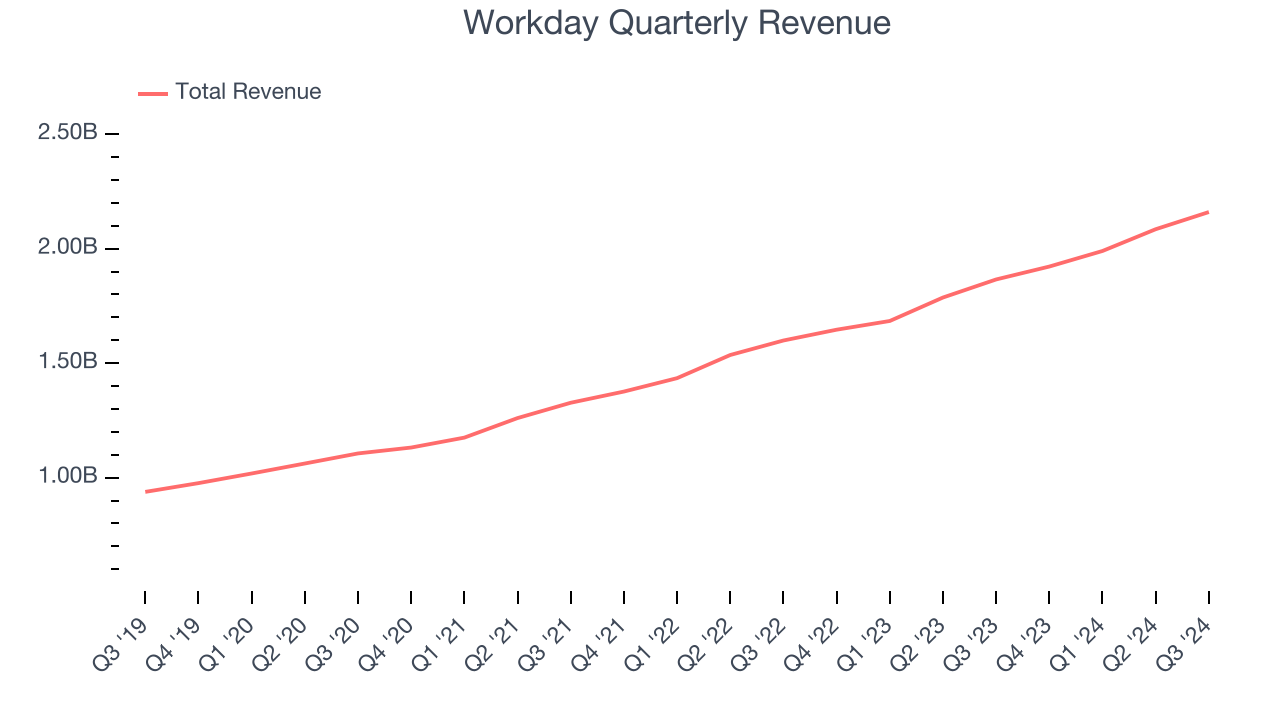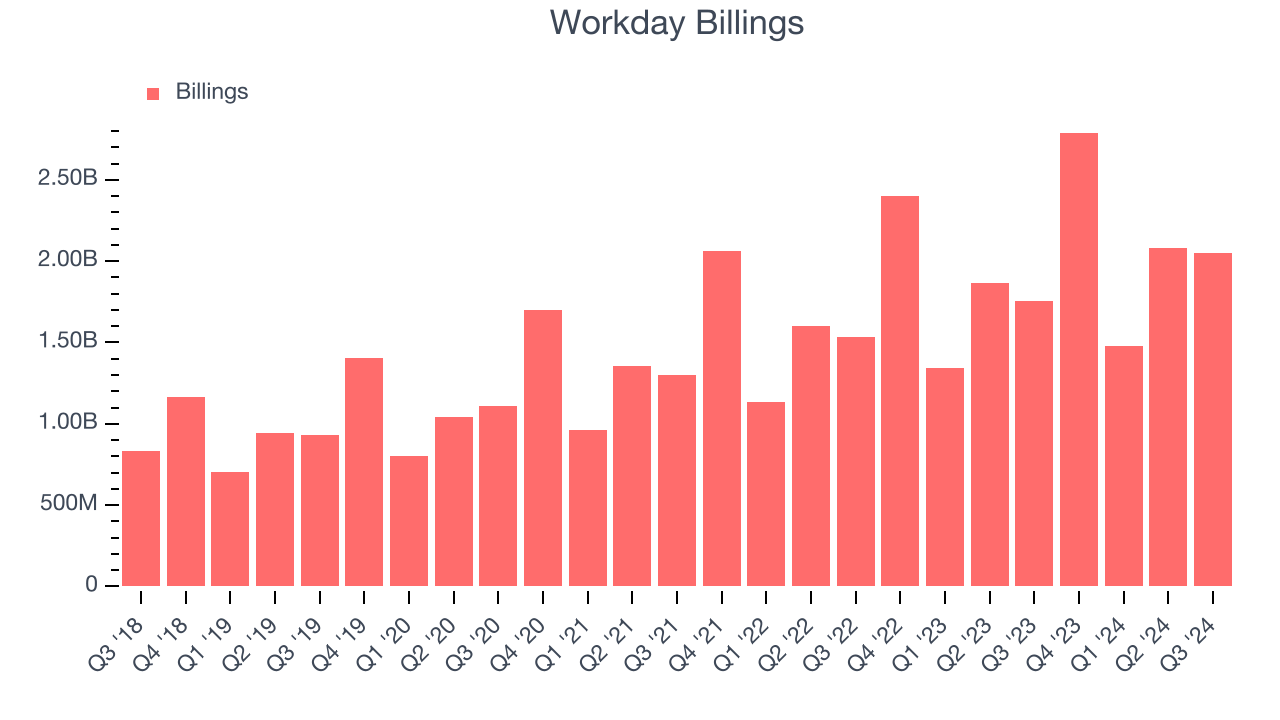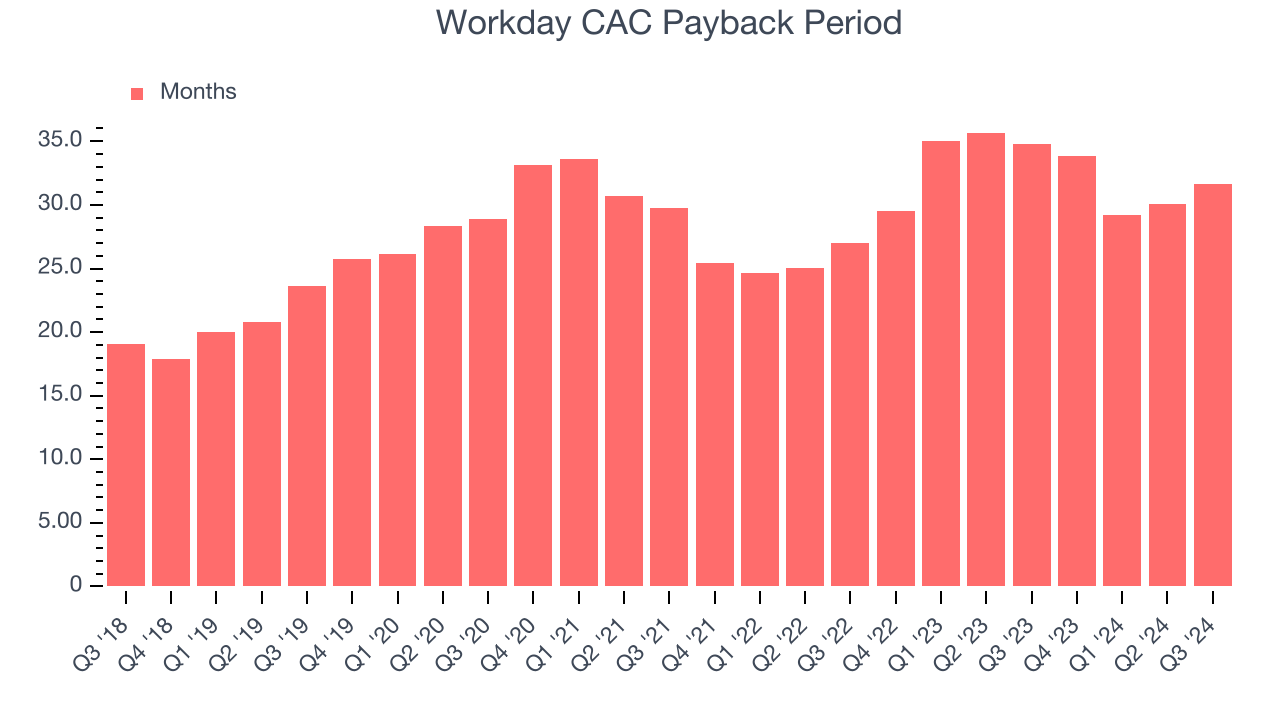
Finance and HR software company Workday (NASDAQ:WDAY) reported Q3 CY2024 results exceeding the market’s revenue expectations, with sales up 15.8% year on year to $2.16 billion. Its non-GAAP profit of $1.89 per share was 7.5% above analysts’ consensus estimates.
Is now the time to buy Workday? Find out by accessing our full research report, it’s free.
Workday (WDAY) Q3 CY2024 Highlights:
- Revenue: $2.16 billion vs analyst estimates of $2.13 billion (15.8% year-on-year growth, 1.4% beat)
- Adjusted EPS: $1.89 vs analyst estimates of $1.76 (7.5% beat)
- Adjusted Operating Income: $569 million vs analyst estimates of $540.2 million (26.3% margin, 5.3% beat)
- Q4 subscription revenue guidance of $2.025 billion, slight miss vs. expectations of $2.040 billion
- Q4 operating margin (non-GAAP) guidance of 25.0%, slight miss vs. expectations of 25.5%
- Operating Margin: 7.6%, up from 4.7% in the same quarter last year
- Free Cash Flow Margin: 16.6%, down from 24.7% in the previous quarter
- Billings: $2.05 billion at quarter end, up 16.8% year on year
- Market Capitalization: $70.64 billion
"Workday's solid performance in Q3 reflects the trust our customers place in us across industries, the global momentum around our AI-driven innovations, and the strength of our partner ecosystem," said Carl Eschenbach, CEO, Workday.
Company Overview
Founded by industry veterans Aneel Bushri and Dave Duffield after their former company PeopleSoft was acquired by Oracle in a hostile takeover, Workday (NASDAQ:WDAY) provides cloud-based software for organizations to manage and plan finance and human resources.
Finance and Accounting Software
Finance and accounting software benefits from dual trends around costs savings and ease of use. First is the SaaS-ification of businesses, large and small, who much prefer the flexibility of cloud-based, web-browser delivered software paid for on a subscription basis than the hassle and expense of purchasing and managing on-premise enterprise software. Second is the consumerization of business software, whereby multiple standalone processes like supply chain and tax management are aggregated into a single, easy to use platforms.
Sales Growth
A company’s long-term sales performance signals its overall quality. Even a bad business can shine for one or two quarters, but a top-tier one grows for years. Over the last three years, Workday grew its sales at a 18.6% compounded annual growth rate. Although this growth is solid on an absolute basis, it fell slightly short of our benchmark for the software sector. Luckily, there are other things to like about Workday.

This quarter, Workday reported year-on-year revenue growth of 15.8%, and its $2.16 billion of revenue exceeded Wall Street’s estimates by 1.4%.
Looking ahead, sell-side analysts expect revenue to grow by 13.5% over the next 12 months. This projection is still commendable and indicates the market is baking in success for its products and services.
Here at StockStory, we certainly understand the potential of thematic investing. Diverse winners from Microsoft (MSFT) to Alphabet (GOOG), Coca-Cola (KO) to Monster Beverage (MNST) could all have been identified as promising growth stories with a megatrend driving the growth. So, in that spirit, we’ve identified a relatively under-the-radar profitable growth stock benefiting from the rise of AI, available to you FREE via this link.
Billings
Billings is a non-GAAP metric that is often called “cash revenue” because it shows how much money the company has collected from customers in a certain period. This is different from revenue, which must be recognized in pieces over the length of a contract.
Workday’s billings punched in at $2.05 billion in Q3, and over the last four quarters, its growth slightly outpaced the sector as it averaged 13.7% year-on-year increases. This alternate topline metric grew slower than total sales, meaning the company recognizes revenue faster than it collects cash - a headwind for its liquidity that could also signal a slowdown in future revenue growth. 
Customer Acquisition Efficiency
The customer acquisition cost (CAC) payback period represents the months required to recover the cost of acquiring a new customer. Essentially, it’s the break-even point for sales and marketing investments. A shorter CAC payback period is ideal, as it implies better returns on investment and business scalability.
Workday is quite efficient at acquiring new customers, and its CAC payback period checked in at 31.7 months this quarter. The company’s performance indicates it has a strong brand reputation, giving it the freedom to invest in new product initiatives while maintaining optionality. 
Key Takeaways from Workday’s Q3 Results
It was good to see Workday narrowly top analysts’ revenue expectations this quarter. On the other hand, its billings missed. Guidance also fell slightly short, with Q4 subscription revenue and non-GAAP operating margin missing by a bit. Overall, this quarter could have been better. The stock traded down 3.3% to $261.36 immediately after reporting.
The latest quarter from Workday’s wasn’t that good. One earnings report doesn’t define a company’s quality, though, so let’s explore whether the stock is a buy at the current price. We think that the latest quarter is only one piece of the longer-term business quality puzzle. Quality, when combined with valuation, can help determine if the stock is a buy. We cover that in our actionable full research report which you can read here, it’s free.
